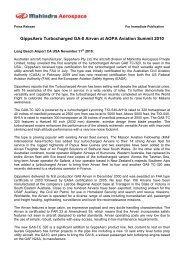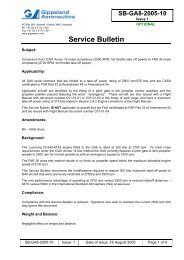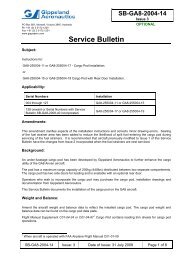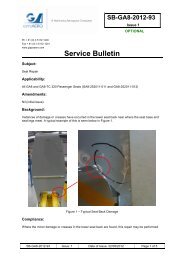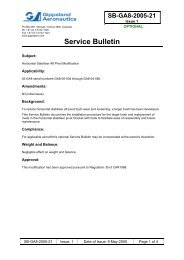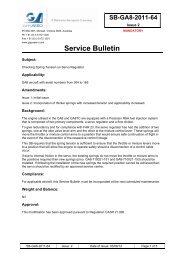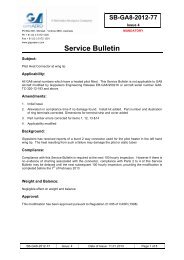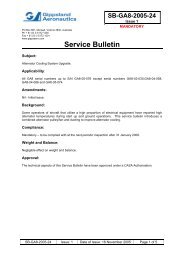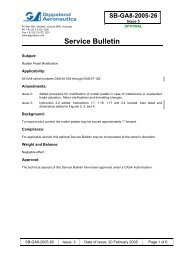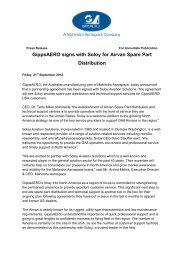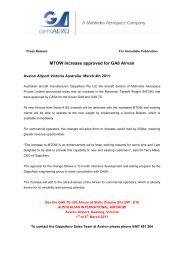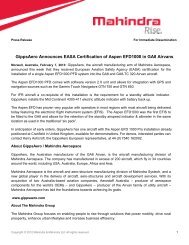SL-GA8-2006-04 - GippsAero
SL-GA8-2006-04 - GippsAero
SL-GA8-2006-04 - GippsAero
Create successful ePaper yourself
Turn your PDF publications into a flip-book with our unique Google optimized e-Paper software.
PO Box 881, Morwell, Victoria 3840, Australia<br />
Ph + 61 (0) 3 5172 1200<br />
Fax + 61 (0) 3 5172 1201<br />
www.gippsaero.com<br />
Service Letter<br />
Subject:<br />
<strong>SL</strong>-<strong>GA8</strong>-<strong>2006</strong>-<strong>04</strong><br />
Issue 1<br />
This service letter is intended to provide a guide for an efficient method of assembling a <strong>GA8</strong> received in a<br />
shipping container. These instructions are not to be used in isolation, as reference must always be made to<br />
the approved aircraft documentation and all work must be carried out and certified in accordance with the<br />
requirements of the appropriate National Airworthiness Authority.<br />
Gippsland Aeronautics strongly recommends that personnel involved in the assembly and maintenance of<br />
the <strong>GA8</strong> Airvan complete factory delivered <strong>GA8</strong> Maintenance Familiarisation training.<br />
Applicability:<br />
All <strong>GA8</strong> aircraft containerised for transport.<br />
Amendments:<br />
Nil – initial issue<br />
Background:<br />
For overseas transport the <strong>GA8</strong> is disassembled and crated into a sea container. The principle of the design<br />
of the “in container” fuselage support frame (main undercarriage legs removed) requires the container to be<br />
at ground level for minimum effort to remove fuselage in terms of man-hours, safety considerations and ease<br />
of assembly.<br />
The fuselage support frame is attached to the nose leg and main undercarriage pick-up points, its base<br />
allows the fuselage assembly to be slid out onto the hangar floor, and is at a comfortable/suitable work<br />
height, to prepare wing and empennage mounting points for assembly. Following the fitting of the complete<br />
empennage and wings, the standard wing jack points can be used to raise the aircraft to a suitable height to<br />
install and secure the main and nose undercarriage. Aircraft is stabilised for and aft via the tail support point<br />
provided in the ventral fin.<br />
Instructions:<br />
1. Equipment Required<br />
1.1. Packing pieces/sloping ramps will be required to remove the fuselage from the container.<br />
NOTE:<br />
This is to prevent the tail end of the fuselage contacting the roof if the nose<br />
is lowered too quickly.<br />
1.2. Standard set of AF spanners, wrenches and sockets.<br />
1.3. Battery powered drills, screwdrivers for quick removal of industrial hex head screw fasteners used for<br />
securing and packing.<br />
1.4. Wing installation trestles and supports: can be supplied by the factory or alternatively can be built from<br />
factory supplied sketches.<br />
1.5. Aircraft jacks (Cessna single engine wing type jacks are suitable – compressed height approximately<br />
70 inches, extended height approximately 80 inches above ground).<br />
<strong>SL</strong>-<strong>GA8</strong>-<strong>2006</strong>-<strong>04</strong> Issue: 1 Date of Issue: 5 June <strong>2006</strong> Page 1 of 13
1.6. Suitable padding/trestles to support the wings and tail surfaces on while cleaning, inspecting and<br />
lubricating fittings as required prior to assembly. Support wings under “double ribs,” identified by the<br />
double rivet rows/runs.<br />
1.7. Lubricants as per <strong>GA8</strong> Service Manual Chapter section 12-20-30.<br />
2. Personnel/Labour Requirements<br />
2.1. Assuming the use of wing support trestle (on wheels and height adjustable), approximately five people<br />
to remove fuselage and wings for approximately one hour. Occasionally three men for three hours<br />
and two men for approximately fifteen hours each. The typical re-assembly should take approximately<br />
fifty to sixty man-hours labour.<br />
3. Removal of Aircraft from Container<br />
Description Initial Date<br />
Before opening container door check seal installed – may have been<br />
replaced by customs, but should be intact.<br />
Open doors and Inspect for any damage, corrosion from seawater, etc. If<br />
damage is apparent take photos and contact insurance company prior to<br />
proceeding.<br />
You will require authorisation by Insurance to proceed further should<br />
damage be apparent.<br />
Remove any items stowed on front of or around fuselage that would impede<br />
removal. Items stowed in the rear of container between wings can remain<br />
until easy access is gained by removal of fuselage.<br />
Remove restraining straps from fuselage support frame and slide/wheel<br />
out, being careful not to prematurely lower nose that may result in damage<br />
to upper surface of rear fuselage by contacting the container roof.<br />
Remove entire fuselage assembly clear of container by at least 25 feet (8<br />
metres) to allow easy removal of wings from container.<br />
NOTE:<br />
Wing, struts and horizontal stabilizer fittings and attach hardware etc. can be<br />
cleaned, inspected and anti-seize lubrication carried out and installed<br />
immediately if desired, or can be removed from container and rested on<br />
suitable padded trestles etc. to allow rapid container despatch.<br />
<strong>SL</strong>-<strong>GA8</strong>-<strong>2006</strong>-<strong>04</strong> Issue: 1 Date of Issue: 5 June <strong>2006</strong> Page 2 of 13
4. Horizontal Stabilizer/Elevator Assembly Installation<br />
Description Initial Date<br />
To remove from container, use two persons to support horizontal stabilizer<br />
and elevator assembly. Using battery-powered driver remove fasteners.<br />
Remove complete assembly from container, carry out inspection for<br />
shipping damage, place on suitable trestles/tables, clean attachment<br />
fittings, bolts etc, lubricate with general purpose grease and ensure trim<br />
jack shaft is clean and lubricated IAW <strong>GA8</strong> Service Manual Chapter 12-20-<br />
30. Also clean and lubricate rear stabiliser attachment fittings and pivot<br />
bushes.<br />
NOTE:<br />
Ensure that the stabiliser trim jack shaft has<br />
remained secured by cable-ties to the bulkhead<br />
just forward. If the shaft is not secured and the<br />
forward trim wheel has been moved, there is a<br />
possibility that the trim system rigging may have<br />
become incorrect and will require checking IAW<br />
<strong>GA8</strong> Service Manual Chapter 27-30-10.<br />
With the aid of a person on either tip, lift assembly into position above rear<br />
fuselage pivot attach fittings.<br />
NOTE:<br />
Ensure pivot bushes are installed.<br />
Utilizing a third person, install NAS6605-20 bolts (heads outboard) AN960–<br />
516 washers, MS21<strong>04</strong>2-5 nuts and correctly torqued IAW <strong>GA8</strong> Service<br />
Manual Chapter 20-10-00 and install theAN356-524 pal nuts. Check that<br />
the leading edge of stabilizer moves up and down without binding. It is<br />
required that the outer flanges of the tailplane fitting clamp tightly on inner<br />
pivot bush to ensure the bushing rotates in the rear fuselage lug.<br />
Slide the upper end of the trim jack between front spar attach fittings<br />
ensuring that the anti rotation spacers are fitted. Install the AN5-14A bolt<br />
with AN960-516 washer under the head, MS21<strong>04</strong>2-5 nut and washer, and<br />
torque IAW <strong>GA8</strong> Service Manual Chapter 20-10-00. Install AN356-524 Pal<br />
nut and ensure uniball bearing is clamped tightly.<br />
Attach trim indicator operating cable on the forward face of the front spar.<br />
Check stabilizer and indicator rigging IAW <strong>GA8</strong> Service Manual Chapter 27-<br />
30-10 and Type Certificate Data Sheet.<br />
Connect both elevator push rods to the elevator operating horns torque<br />
bolts IAW <strong>GA8</strong> Service Manual Chapter 20-10-00.<br />
<strong>SL</strong>-<strong>GA8</strong>-<strong>2006</strong>-<strong>04</strong> Issue: 1 Date of Issue: 5 June <strong>2006</strong> Page 3 of 13
5. Vertical Fin Installation<br />
Description Initial Date<br />
Clean and inspect forward and rear spar attach holes, faces and bolts.<br />
Apply a light coating of preferred corrosion protection (i.e. LPS3 or similar).<br />
Three persons and a 10 ft (3 metre) high stepladder or work platform are<br />
preferable for fin initial installation.<br />
Pass the fin assembly to person on ladder/work platform and lower the<br />
assembly down into position ensuring correct fore/aft alignment.<br />
Loosely install 2 bolts in front and rear fin spars to safely hold fin in position.<br />
One person can finish the installation and torquing of the bolts in the rear<br />
spar, two persons required to correctly torque forward spar bolts.<br />
NOTE:<br />
Ensure unthreaded portion of all bolts protrudes<br />
through spars and bulkheads and sufficient<br />
washes are used under the nut to prevent nut<br />
binding.<br />
Correctly torque all nuts IAW <strong>GA8</strong> Service Manual Chapter 20-10-00.<br />
Connect the strobe light/beacon and radio coax cables at the base of the<br />
fin.<br />
6. Rudder Installation<br />
Description Initial Date<br />
Clean and inspect rudder, hinge pivots and mass balance attachments.<br />
Lubricate pivot bushes and hinge holes with grease.<br />
Rudder can be installed with lower mass balance weight fitted – upper<br />
balance weight must be removed.<br />
NOTE:<br />
<strong>GA8</strong> IPC Chapter 27 Figure 27-37 shows correct<br />
installation of rudder pivot bushes and attach<br />
hardware.<br />
Install upper and middle hinge bushes and bolts.<br />
Take particular notice of Note 1 of IPC Figure 27-37 regarding “spacer”<br />
washers and lower hinge bolt length. Spacer washers should be added<br />
until just taking up the gap.<br />
Install lower washes and MS21<strong>04</strong>2 nuts, tighten and ensure pivot bushes<br />
are clamped and rotate with rudder.<br />
<strong>SL</strong>-<strong>GA8</strong>-<strong>2006</strong>-<strong>04</strong> Issue: 1 Date of Issue: 5 June <strong>2006</strong> Page 4 of 13
Description Initial Date<br />
Connect rudder cables.<br />
NOTE:<br />
It is usual that rudder cables are disconnected<br />
without disturbing the original rigging and the lock<br />
wire should be found intact. They can easily be<br />
reconnected by attaching one cable, then with the<br />
nose wheel held in position, moderate pressure on<br />
the trailing edge at lower rib position of rudder will<br />
allow easy installation of the second rudder clevis<br />
bolt.<br />
Install both castellated nuts and split pin.<br />
Place the upper mass balance weight in position and install the 2 x AN4<br />
bolts and washers leaving the bolts loose enough so that the weight can be<br />
rotated to align the pop rivet holes at each end of the weight. When the<br />
holes are aligned the bolts can be tightened and the pop rivets installed.<br />
NOTE:<br />
If the pop rivet holes do not align then the weight<br />
may need to be swapped end for end.<br />
Check complete rudder system installation IAW <strong>GA8</strong> Service Manual<br />
Chapter 27 Section 27-20-00.<br />
7. Wing Installation<br />
NOTE:<br />
Whether the aircraft is on the shipping fuselage support frame or is on its wheels, it<br />
is stable with only one wing attached (assuming no fuel).<br />
Description Initial Date<br />
Clean, inspect and grease all wing, strut, fuselage pick up points and bolts<br />
etc.<br />
Remove all blanking, packaging tape from fuel supply and vent lines. Check<br />
and ensure they are all clear. Lightly grease outer surface of pipes and<br />
inner surface of rubber sleeves to allow easy assembly.<br />
Lift wing assembly onto mobile wing rigging trestle (or manhandle with 4-5<br />
people) and adjust to correct height. Move wing assembly carefully<br />
towards correct position while feeding the aileron control cables into their<br />
correct positions, also ensue smooth insertion of fuel supply and vent lines.<br />
NOTE:<br />
On left hand side fuselage rear spar ensure cam<br />
adjusters (if fitted) are well greased and inserted<br />
and the bolt holes aligned with each other. It has<br />
generally been found that balanced flight in terms<br />
of roll is achieved with the rear spar near the<br />
lowered position.<br />
When front and rear spar holes are aligned in fittings, install bolts.<br />
See <strong>GA8</strong> IPC Chapter 57 Figure 57-1.<br />
<strong>SL</strong>-<strong>GA8</strong>-<strong>2006</strong>-<strong>04</strong> Issue: 1 Date of Issue: 5 June <strong>2006</strong> Page 5 of 13
Strut Installation – Lower End (See <strong>GA8</strong> IPC Figure 57-2)<br />
Description Initial Date<br />
Identify lower end of strut and carefully insert into position.<br />
NOTE:<br />
Ensure fork mating surfaces are well greased to<br />
prevent galling during insertion.<br />
Line up lower boltholes and partially insert bolt. Partial insertion allows<br />
slight twisting or radial movement of strut thus aiding installation alignment<br />
at the upper end.<br />
Strut Installation – Upper end (See <strong>GA8</strong> IPC Figure 57-2)<br />
Description Initial Date<br />
Again make sure the wing mounted strut attach lug faces are well greased<br />
to prevent galling. Raise upper end of strut and insert into position. If wing<br />
lugs appears too far apart a G clamp can be successfully used to slightly<br />
squeeze or spring them together to allow entry into the strut fork.<br />
Raise or lower wing to align boltholes, locate tie down bracket into position<br />
and install bolt.<br />
Install all double locking nuts.<br />
NOTE:<br />
It is easier to feed the 2 nuts into the lower strut<br />
attach bolt progressively as the bolt is moved in,<br />
due to limited access. Modified open-end<br />
spanners or wrenches can be used.<br />
Carefully tighten all primary nuts and then lock secondary nuts onto the<br />
primary nut.<br />
Fuel and Vent Lines<br />
NOTE:<br />
The primary and secondary nuts are an FAA<br />
requirement, however they are awkward and<br />
require considerable care to install correctly as<br />
intended, especially the smaller diameter nuts as<br />
on the rear spar bolts, they are narrower than most<br />
spanners and wrenches and the threads in these<br />
nuts can strip very easily if over torqued due to the<br />
limited number of threads in each nut.<br />
Description Initial Date<br />
Ensure rubber hose joining sleeves are centred over the gap between the<br />
ends of the pipes, also that sufficient engagement has been achieved to<br />
allow correct clamping and sealing by the hose clamps. Tighten all hose<br />
clamps.<br />
NOTE:<br />
Care should be taken when starting threads on all<br />
fuel line fittings at the wing roots as they can be<br />
easily cross threaded and damaged. Care should<br />
also be also be exercised to ensure that all fitted<br />
are well supported when tightened.<br />
<strong>SL</strong>-<strong>GA8</strong>-<strong>2006</strong>-<strong>04</strong> Issue: 1 Date of Issue: 5 June <strong>2006</strong> Page 6 of 13
Control Cables Systems - Ailerons<br />
Description Initial Date<br />
Ensure correct routing of aileron left and right driving and balance cables.<br />
Ensure sufficient, even and correct thread engagement in turn barrels.<br />
Carry out Rigging and Cable tension IAW <strong>GA8</strong> Service Manual Section 27-<br />
10-00.<br />
Control Cables Systems – Flaps (See <strong>GA8</strong> IPC Figure 27-7)<br />
Description Initial Date<br />
Connect cables to Flap Torque tube operating arms. Ensure sufficient even<br />
and correct thread engagement in turnbuckles.<br />
Carry out rigging and cable tension IAW <strong>GA8</strong> Service Manual Section 27-<br />
50-00.<br />
Electrical Connectors<br />
Description Initial Date<br />
Identify and correctly connect plugs located left and right leading edge<br />
section of wing roots.<br />
Pitot/Static Lines<br />
Description Initial Date<br />
Locate and connect in Left hand wing root.<br />
Pitot Static Head Assembly<br />
Description Initial Date<br />
Remove left hand fibreglass tip faring (<strong>GA8</strong> IPC Figure 57-1 Item 3, Part<br />
No. <strong>GA8</strong>-571019-11).<br />
Pitot-static assembly is stored inside with the pitot and static lines<br />
connected. The mount bolts and stand off spacers can be found in their<br />
appropriate holes in the end rib. Attach the pitot head using the hardware<br />
as removed (connect the plug for the heated pitot and test if fitted).<br />
Check pitot-static lines are correctly installed and tightened.<br />
Carry out a pitot-static leak check IAW <strong>GA8</strong> Service Manual Section 34-10-<br />
00.<br />
Install the tip fairing.<br />
<strong>SL</strong>-<strong>GA8</strong>-<strong>2006</strong>-<strong>04</strong> Issue: 1 Date of Issue: 5 June <strong>2006</strong> Page 7 of 13
8. Undercarriage Installation<br />
Description Initial Date<br />
Install wing jacks and tail support IAW <strong>GA8</strong> Service Manual Section 7. Pay<br />
attention to Caution regarding empty weight longitudinal centre of gravity.<br />
Raise aircraft sufficiently to remove weight from main undercarriage and<br />
nose leg attach bolts from shipping fuselage support frame. Raise aircraft<br />
clear of frame, remove inboard securing bolts from main undercarriage<br />
support bars and remove from fuselage.<br />
Clean and inspect main undercarriage legs, fuselage mounting fittings,<br />
nose leg fork and mounting pad.<br />
Lightly grease faces or apply preferred anti-corrosion treatment (LPS 3 or<br />
similar).<br />
Main Undercarriage<br />
Description Initial Date<br />
Insert main legs into fuselage fittings and install outboard NAS mounting<br />
bolts first (this gives easier access, spanner/wrenches are not continually<br />
hitting inboard bolt heads).<br />
See <strong>GA8</strong> IPC Figure 32-1 Items 33 and 34, <strong>GA8</strong> Service Manual Chapter<br />
32-10-00.<br />
Tighten 16 mounting bolts, double check (independent check<br />
recommended) and install bolt retaining cap.<br />
Install brake caliper onto torque plate and secure pad assembly.<br />
Secure brake line to leg and install the leg fairings.<br />
Nose Wheel (See <strong>GA8</strong> IPC Figure 32-4 View DD)<br />
Description Initial Date<br />
Correctly inflate tyres.<br />
Mains - 29 psi<br />
Nose – 33 psi<br />
Lower aircraft off jacks.<br />
NOTE:<br />
Nose wheel fork is not handed therefore has no<br />
front or rear. Locate fork and wheel assembly, as<br />
shown in View DD. Install 4 mounting bolts,<br />
washers and nuts and correctly torque.<br />
<strong>SL</strong>-<strong>GA8</strong>-<strong>2006</strong>-<strong>04</strong> Issue: 1 Date of Issue: 5 June <strong>2006</strong> Page 8 of 13
9. Electrical System<br />
Battery<br />
Description Initial Date<br />
It would be preferable to ensure aircraft battery is fully charged. This can<br />
be accomplished by either removing the battery and charging on 14 volt<br />
charger as required by battery manufacturers recommendations (supplied<br />
in Aircraft Documents), or using 3 pin ground power plug, connect 14 volt<br />
Ground power until current drain is nearly zero or with aircraft master<br />
switches on, battery voltage is 14 volts.<br />
Electrical System Checks<br />
NOTE:<br />
When battery is only partially charged Voltage<br />
indication is proportionally lower i.e. 10 to 14 volts.<br />
Description Initial Date<br />
With ground power installed or battery fully charged, turn on Master<br />
Switches.<br />
Ensure all breakers are in and check operation of all electrical systems in<br />
particular the following items disturbed by disassembly.<br />
<br />
<br />
Nav Lights<br />
Strobe Lights<br />
Pitot Heat – ensure pitot heat cover is removed, short test to prevent<br />
overheating, beware of burns.<br />
10. Final Checks<br />
Fuel System Leak Check<br />
Description Initial Date<br />
Ensure fuel drains are tight (are left loose following de-fuelling prior to<br />
disassembly) and closed.<br />
Brake System<br />
Add approximately ¼ fuel to each tank and check for leaks.<br />
NOTE:<br />
A slow leak may take some time to become visible,<br />
preferably leave overnight.<br />
Description Initial Date<br />
Cycle brake pedals until pedal becomes firm (this action moves the pistons<br />
out in the wheel calipers until they are in the normal position). Remove fill<br />
cap from Master Cylinder, and using a torch/flashlight ensure reservoir is at<br />
least ¾ full – MIL-H-5606 hydraulic fluid.<br />
<strong>SL</strong>-<strong>GA8</strong>-<strong>2006</strong>-<strong>04</strong> Issue: 1 Date of Issue: 5 June <strong>2006</strong> Page 9 of 13
Flight Controls/Wings/Empennage<br />
Description<br />
Carry out independent inspections of the following installations and systems:<br />
a) Installation attach fasteners and locking of wings and empennage<br />
b) Primary flight control systems<br />
c) All control surface attach points are correctly installed and locked.<br />
First inspection Signature Authority Number Date<br />
Second inspection Signature Authority Number Date<br />
Engine<br />
Description Initial Date<br />
Install all interior trim panels, seats and carpets.<br />
Install all fairings.<br />
Description Initial Date<br />
De-inhibit engine as per Lycoming service letter <strong>SL</strong>-L180B.<br />
Carry out inspection forward of firewall to ensure:<br />
a) All engine controls are correctly installed, operation correct.<br />
b) Silica – Moisture absorbent bags etc. removed.<br />
c) Oil System – correct level and oil type.<br />
d) Remove covers from exhaust tail pipes.<br />
e) Engine may need cleaning externally to remove excess corrosion<br />
inhibitor applied prior to shipping.<br />
Install all engine cowls.<br />
<strong>SL</strong>-<strong>GA8</strong>-<strong>2006</strong>-<strong>04</strong> Issue: 1 Date of Issue: 5 June <strong>2006</strong> Page 10 of 13
Engine Ground Run<br />
Carry out the following engine ground run:<br />
Record OAT _____°C Record Altitude _______ ft Static MP _______in.Hg<br />
Item Description Result<br />
1 Auxiliary fuel pump operation (record pressure mixture ICO) psi<br />
2 Normal cranking and starting Yes / No<br />
3 Oil pressure rising (light off) Yes / No<br />
4 Alternator light off Yes / No<br />
5 Ammeter charging Yes / No<br />
6 Vacuum light off and gauge indicating Yes / No<br />
7 CHT rising Yes / No<br />
8 Engine warm Yes / No<br />
9 Shut down and check for leaks OK / Not OK<br />
10 Re-install cowls and repeat engine start and warm-up Items 1<br />
through 8<br />
OK / Not OK<br />
11 Magneto check at 1800 RPM<br />
Mag drop LH Mag Selected<br />
RPM<br />
RPM<br />
Mag drop RH Mag Selected<br />
12 Pitch operation normal (cycle prop at 1500 RPM) Yes / No<br />
13 Record at Full Throttle<br />
Full throttle check not to exceed 30<br />
seconds<br />
Ensure tarmac is clear of debris<br />
RPM<br />
Manifold Pressure<br />
Vacuum<br />
Oil Pressure<br />
RPM<br />
in.Hg<br />
in.Hg<br />
psi<br />
Oil Temperature °C<br />
Fuel Pressure<br />
Fuel Flow<br />
psi<br />
L/Hr<br />
CHT °C<br />
EGT Recording<br />
Yes / No<br />
<strong>SL</strong>-<strong>GA8</strong>-<strong>2006</strong>-<strong>04</strong> Issue: 1 Date of Issue: 5 June <strong>2006</strong> Page 11 of 13
14 Record at Idle Idle Normal Yes / No<br />
RPM<br />
Oil Pressure<br />
RPM<br />
psi<br />
Oil Temperature °C<br />
Magneto Dead Cut<br />
Idle Mixture Check<br />
Normal Shut Down<br />
Yes / No<br />
Lean / OK / Rich<br />
Yes / No<br />
15 Abnormal vibrations at any RPM Yes / No<br />
16 Engine security and leak check OK / Not OK<br />
17 Ensure all panels installed Yes / No<br />
18 Engine run carried out<br />
(Refer Lycoming Operator’s Manual<br />
Section 3)<br />
Print Name<br />
Signed<br />
Date<br />
19 Remarks:<br />
Description Initial Date<br />
Check correct operation of avionics.<br />
When moving off to taxi check brakes – correct operation.<br />
Prepare aircraft for flight.<br />
Complete log book entries and certify. Check and ensure all AD’s, SB etc<br />
have been carried out, complied with as required by the country’s National<br />
Airworthiness Authority.<br />
<strong>SL</strong>-<strong>GA8</strong>-<strong>2006</strong>-<strong>04</strong> Issue: 1 Date of Issue: 5 June <strong>2006</strong> Page 12 of 13
11. Flight Check and Delivery<br />
Description Initial Date<br />
During check flight: observe all systems for normal operation.<br />
In smooth air at approximately 23” in.Hg MP, 2300 RPM check lateral<br />
rigging (i.e. does aircraft tend to roll left or right).<br />
NOTE:<br />
Skid ball should be checked prior to flight, must be<br />
centred when cabin floor laterally level.<br />
Adjust rear spar cam adjuster IAW Service Letter <strong>SL</strong>-<strong>GA8</strong>-20<strong>04</strong>-02 to<br />
ensure hands off, wings level.<br />
NOTE:<br />
If aircraft is tending to yaw, ball must be kept<br />
centred with rudder application.<br />
NOTE:<br />
For aircraft not fitted with a rudder trim tab, refer to<br />
Service Bulletin SB-<strong>GA8</strong>-2005-22 for rudder tab<br />
installation and adjustment.<br />
Ensure the exterior of aircraft is clean.<br />
Ensure interior is clean. Fingermarks removed, carpet vacuumed.<br />
Ensure seats installed correctly.<br />
Ensure all shoulder harnesses installed correctly.<br />
All customer ordered items present and correct.<br />
<strong>SL</strong>-<strong>GA8</strong>-<strong>2006</strong>-<strong>04</strong> Issue: 1 Date of Issue: 5 June <strong>2006</strong> Page 13 of 13



